Well, I decided I should make a trip over these remaining CLC lines again and, this time, take some pictures. I planned a series of journeys using the National Rail Enquiries site which I find fairly reliable and, in fact, all my connections during the day worked well.
The Saturday I chose, 4th October 2014, was rather wet in the morning but improved later with occasional light showers. I'd intended to start with the 06:37 Virgin 'Pendolino' from Wolverhampton but I arrived at the station in time to catch the earlier 'London Midland' service to Liverpool so I boarded that as far as Crewe. Crewe was rather rainswept but, arriving earlier than planned, there was an 'Arriva Trains Wales' train for Llandudno about to leave number 10 bay platform which took me to Chester prior to the train I'd planned. It was still pretty dark so I couldn't see much on the journey. The original CLC station in Chester - Chester Northgate - is long gone so my journey started at the remaining Chester station, formerly Chester General.
Chester Station
At Chester, we arrived at the long platform 3 which can hold an 18-coach train. I had a quick look outside the station but the morning was slow to get light and the rain continued so I soon ducked inside again and crossed to the island platform. I watched a 'Merseyrail' electric arrive and depart from platform 7b. I don't think I'll ever get used to third-rail electrics at Chester, as I commented in the post on an earlier trip via Chester Birkenhead and New Brighton by train (Part 1).
Various other trains arrived and departed but I was waiting for the 07:59 to Manchester via the CLC line. This was scheduled to depart from bay platform 6. The overall roof covering bays 5 and 6 at the east end of the station is now completely separate from the main overall roof so I had to 'run the gauntlet' of a section of rainswept platform to get from the main part of the station to the roofed section over the bays. The roof kept the rain off but a fairly strong wind made conditions fairly unpleasant. A Class 142 'Pacer', shut down, stood in bay 6 so that did little to lift the spirits of the small group of waiting passengers (did I mention I'm not a fan of 4-wheel railcars built of bus parts?).
 Chester Station (in the rain): Class 156 in bay 5, Class 142 in bay 6. View looking west shows that the overall roof over the bays is separate from the main station roofing.
Chester Station (in the rain): Class 156 in bay 5, Class 142 in bay 6. View looking west shows that the overall roof over the bays is separate from the main station roofing.
However, about ten minutes before departure, a class 156 appeared and stopped in bay 6, a few yards short of the 'Pacer', disgorging quite a few passengers. The driver and guard from this train transferred to the 'Pacer' and, after starting-up, the driver coupled the two sets together and the guard completed his checks and let the passengers board. I assume the 'Pacer' was available to passengers, but I didn't spot anybody use it.
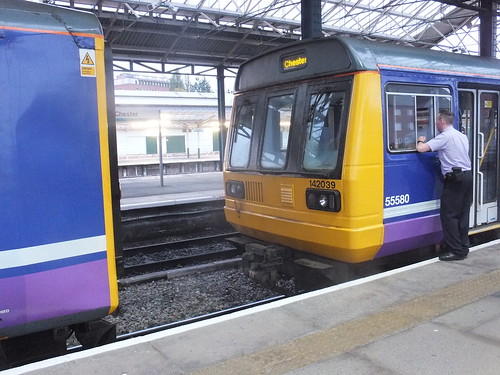 Chester Station: The driver is about to couple the Class 142 to the Class 156 as the guard looks on.
Chester Station: The driver is about to couple the Class 142 to the Class 156 as the guard looks on.
Chester - Manchester via the CLC
The colour light signal for bay 6, CR72, turned 'green' with a 'D' in the theatre-type route indicator. I presumed 'D' is for 'Down' (it's Down on the Warrington line), as opposed to 'U' (it's 'Up' heading for Crewe). We set off on the Warrington line, not more than a minute of two late, stopping all stations.
After about two and a half miles we came to Mickle Trafford Junction, with its British Railways Standard signal box, where we turned right at the single line junction to reach the CLC route which originally came from Chester Northgate (and we become an 'Up' train again). The single line now continues about four miles to Mouldsworth, where it becomes double until Altrincham. Originally, the CLC route was double throughout. The last time I was at Mouldsworth, it retained its signal box (I said it was a 'few years' since I last used the routes). Now, Mickle Trafford Junction controls the line almost to Delamere, then Greenbank signal box takes over. Mouldsworth still has its attractive stone-built station building on the Up line, apparently now a private house.
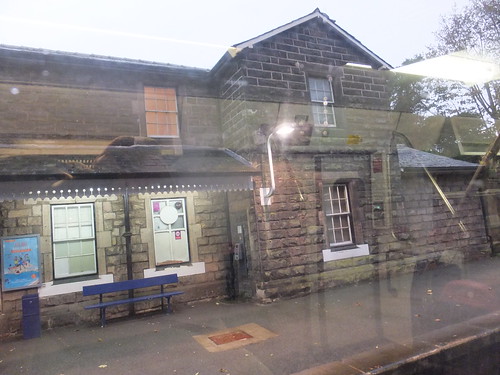 Mouldsworth stone-built station building on Up side.
Mouldsworth stone-built station building on Up side.
The next station is Delamere, set in the ancient and important Delamere Forest. The stone building on the Up side is similar to Mouldsworth, whilst on the Down side there's a simple stone shelter.
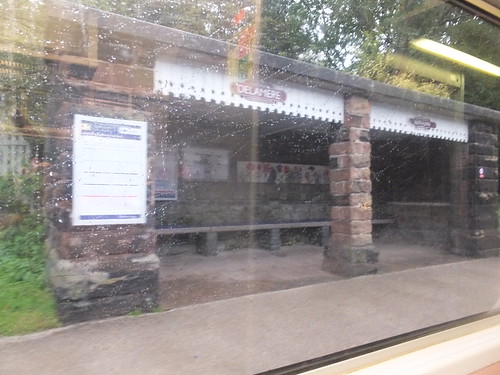 Delamere Station: Shelter on Down side.
Delamere Station: Shelter on Down side.
The Forestry Commission, in lyrical vein, describe the Forest as a "shady oasis in the midst of the agricultural landscape of the Cheshire Plain. Delamere is a place for families to let off steam, escape the crowds and find peace in the heart of the forest". The Wikipedia article here is more restrained but informative.
Another three miles took us to Cuddington station. Although the general layout of the main station building is similar to the previous stations, in this case it is brick built, as is the shelter on the Down side.
A little under two miles further on, the CLC crosses over the double track West Coast Main Line (WCML), just south of the site of Hartford Junction signal box on the LNWR where a double-track branch used to connect with the CLC at (another) Hartford Junction Signal Box. North of Hartford Junction (LNWR) the double track WCML widened to four-tracks paired by direction for a couple of miles to Acton Bridge. Hartford Junction (CLC) box closed in 1976 and this stretch of the CLC is controlled from the British Railways Standard pattern signal box at Greenbank. Hartford Junction (LNWR) is now remotely controlled from Winsford signal box, four miles south. The double track branch still links the West Coast Main Line to the CLC but, as is the modern fashion, at each end of the branch, single-line junctions are provided, eliminating the need for diamond crossings.
Another mile took us to Greenbank Station (which used to be called Hartford and Greenbank). The station building on the Up side is similar to Cuddington, also in brick. The building appears to be in private hands and I was intrigued by a Christian cross mounted on the end wall.
 Brick station building on Up side at Greenbank.
Brick station building on Up side at Greenbank.
The brick shelter on the Down side has a steeply-inclined roof which I think was originally typical of this line.
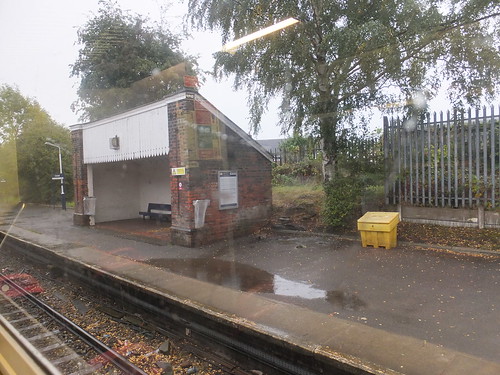 Brick platform shelter on Down platform at Greenbank.
Brick platform shelter on Down platform at Greenbank.
The first of the chemical works around Northwich was the Brunner-Mond chemical works at Winnington, opened 1874 and still in use as part of Tata Chemicals Europe. A triangular junction to the north of the CLC line just east of Greenbank connects to a single line branch which, after one mile, reaches the works now called Northwich West. The products are soda ash, sodium bicarbonate, calcium chloride and associated alkaline chemicals.
We then passed over Northwich Viaduct, around 700 yards long dating from the 1860s. Various sources have rather different details but it's certainly Grade II listed, generally of red sandstone with a total of 47 round arches and a couple of iron spans. It crosses the Weaver Navigation, the River Weaver and the River Dane.
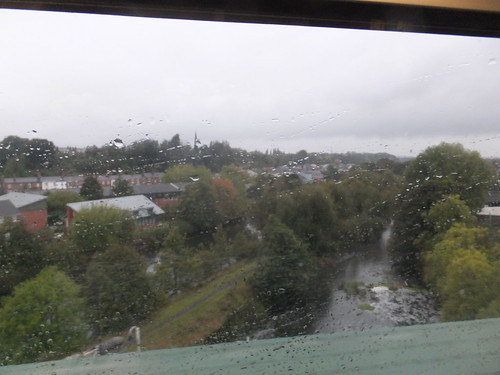 View from Northwich Viaduct in the rain.
View from Northwich Viaduct in the rain.
East of the viaduct, there's another triangular junction, this time on the south of the CLC. This leads to a single line via Middlewich to Sandbach, on the Crewe to Manchester line. I travelled once on this line, 'some years ago' when diversions were in force. I know the motive power was a Class 47, when locomotive-hauled passenger trains were still commonplace and the destination was either Manchester or Liverpool.
Back in the present, my train stopped at the impressive Northwich Station, elaborate brick station buildings provided with a glass canopy on the Up side and a platform clock made by Joyce, showing the correct time. The Down platform was originally an island platform with a glazed canopy but now the 'third line' is available for freight trains only and a 'bus shelter' has been provided for passengers awaiting trains towards Chester.
 Northwich Up side platform (sorry about the rain on the coach window).
Northwich Up side platform (sorry about the rain on the coach window).
Leaving Northwich, we passed the Lostock Chemical Works, now part of Tata Chemicals and called Northwich East, then stopped at Lostock Gralam, at the limit of the control area for Greenbank signal box. Two miles further on, we paused on the approach to Plumley station. When we restarted, I caught a glimpse of a fairly old 2-aspect colour light with a subsidiary aspect underneath. There's a crossover here and a siding on the Down side, together with an elderly wooden signal box. The station building on the Up line at Plumley is the 'standard brick design', similar to Cuddington and Greenbank. Reproduction British Rail 'totems' commemorated 'Cheshire Best Kept Station' awards - a Community Award in 2006 and Winner in 2013.
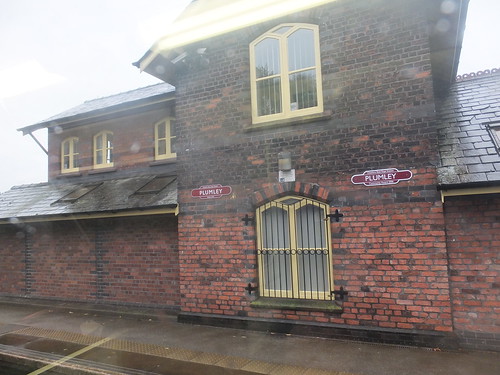 Brick former station building on Up platform at Plumley.
Brick former station building on Up platform at Plumley.
Our next stop was at Knutsford station. Like Northwich, this had rather 'posh' buildings with a glass canopy over the Up platform. Then on to Mobberley, where I failed to spot the signal box on the Down side. The following station, Ashley, had the 'standard brick design' station building on the Up side. Just under two miles took us to Hale, the last of the CLC stations on this route. There's a level crossing just at the Chester end of the station. Barriers are now provided but the former signal box, a small wooden affair which once controlled mechanical crossing gates, survives. I believe barriers were installed in 1974, controlled from Hale signal box but, subsequently, the crossing became supervised by Closed Circuit Television (CCTV) from Deansgate Junction. Hale station also boasts a rather nice glazed canopy supported on cast columns.
Altrincham
Less than a mile took us to Altrincham station. This was the last station on the Manchester, South Junction and Altrincham Railway (MSJ&AR), jointly owned by the London & North Western Railway (LNWR) and the Manchester, Sheffield and Lincolnshire Railway (MS&L). Since the MS&L were one of the partners in the CLC, an end-on junction with the MSJ&AR offered trains from Chester a direct route into Manchester. Altrincham station had two through platforms used by CLC-route trains and two bays for local services. The MSJ&AR including the two bays at Altrincham was electrified in 1931.
In 1992 it was decided to transfer the southern part of the MSJ&AR, together with parts of the abandoned CLC route into Manchester Central, to the Manchester Metrolink Light Rail Project, using the bays at Altrincham to terminate the Metrolink trams. Although CLC-route trains would be denied the MSJ&AR route to Manchester, Deansgate Junction, less than a mile north of Altrincham, already had a branch to another CLC line - the Glazebrook Jn. to Hyde Jn./Godley Jn. Although part of this route had been abandoned,a remaining section from Skelton Junction to Northenden Junction would allow CLC-route trains to take a roundabout route to Stockport, reaching Manchester via the former LNWR line.
A difficulty with this plan was that from Deansgate Junction towards Altrincham as far as the level crossing at Navigation Road, there was not space for additional running lines beyond the existing two. The solution adopted was to convert the double track between Deansgate Junction and Navigation Road into two parallel single lines, with Metrolink using the former Up line for both Inbound and Outbound trams and Network Rail using the former Down line for CLC-route trains in both directions.
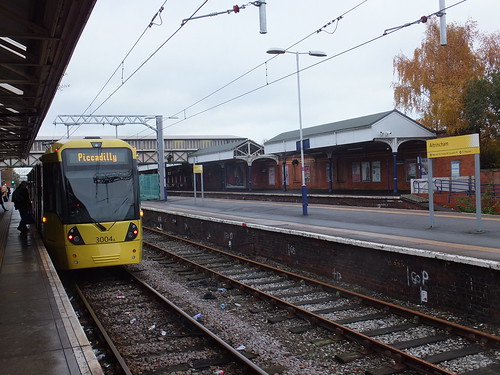 Altrincham station in November 2013. The two platforms in the foreground are used by Metrolink trains, the two in the background by CLC route trains.
Altrincham station in November 2013. The two platforms in the foreground are used by Metrolink trains, the two in the background by CLC route trains.
By former MSJ&AR, CLC and LNWR lines to Manchester
My journey continued from Altrincham with the CLC-route double track converging into a single line through Natigation Road and past Deansgate Jn. signal box, then swinging right and becoming double track again. At Skelton Jn., the line to Glazebrook is merely a stub of single track, and that is now shown as 'out of use'. Northenden Junction signal box survives, controlling the junction with the now-singled route which still extends to Chinley. For two and a half miles our route to Stockport became singled, resuming double track 1300 yards before we joined the Crewe-Manchester main line at Edgeley Junction No. 2 signal box. After our stop in platform 4 at Stockport, we took the Down Slow Line allowing us to call at Heaton Chapel and Levenshulme before finally arriving in platform 10 in Manchester Piccadilly, just 90 minutes after leaving Chester. It was still raining so I abandoned thoughts of spending time in Manchester and made my way across Piccadilly station to platform 14 to catch a Liverpool train via the CLC route.
Manchester - Liverpool via the CLC
East Midland trains provide the fast service along the CLC route to Liverpool. I think Northern Rail provide an all-stations service but I'll try that on another trip. There was a large crowd of people at Manchester Piccadilly to board the 09:37 3-car Diesel Multiple Unit, so I quickly found tip-up seat in a vestibule at the rear of the train and stayed there. At Oxford Road, many people left the train but it was still pretty crowded. We didn't stop at Deansgate, then the brick viaduct built to carry the approach tracks to Manchester Central appeared on the right. This viaduct now just carries the double track of the Manchester Metrolink Altrincham Line. At Castlefield Junction a double track diverged to our right, under a skew truss bridge which originally carried the Manchester Central lines.
This diverging route leads to Ordsall Lane Junction. Here a siding from MOSI (the Museum Of Science and Industry) converges since the museum is the site of the first main line railway terminus in the world at Liverpool Road - the original Manchester terminus of the Liverpool and Manchester Railway (L&M), opened in 1830. There's quite a bit about the museum and my actvities there as a volunteer which you can find here.
Beyond Castlefield Junction, the route from Manchester Central was carried on a lengthy lattice bridge (usually referred to as the 'Birdcage') which is now used by Metrolink trams. The picture below taken from my Liverpool-bound train shows the rather fancy red fencing on the MSJ&AR bridge, part of the canal system, the modern apartments which now occupy the quayside and the massive supports for the lattice bridge on the Manchester Central-route. The brick bridge over the canal in the background carries the diverging line from Castlefield Junction to Ordsall Lane Junction. This line has recently been electrified (electrification of the whole of the L&M route to Liverpool is currently being completed) and a number of portal structures for the Overhead Line Equipment can be seen. Finally, the sawtooth roofline just visible above the apartment building is the 1830 Warehouse of the L&M which is now part of MOSI.
 View from my DMU on the MSJ&AR.
View from my DMU on the MSJ&AR.
At Cornbrook, there was a complex series of junctions between the CLC-route to Liverpool and the MSJ&AR to allow trains to change routes as necessary. Ceding the southern part of the MSJ&AR route to Metrolink has required significant alterations. Metrolink have built a station here, visible as my train moved from the former MSJ&AR route we'd used from Piccadilly to the former CLC route to Liverpool.
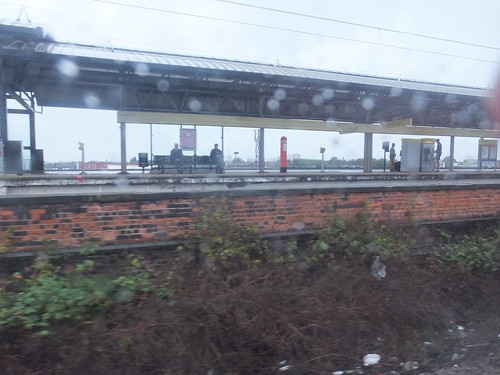 Cornbrook Station on the Manchester Metrolink.
Cornbrook Station on the Manchester Metrolink.
The massive concrete bulk of Manchester United Football Stadium passed on the right, followed by the sidings and Freightliner Terminal at Trafford Park. Electrification at 25 kV a.c. extends only as far as these yards. Travelling at a good clip, we passed through the stations at Trafford Park, Humphrey Park and Urmston, which represents the limit of the control area of Manchester Piccadilly Signalling Control Centre (there's a post describing a visit to this Signal Control Centre here). We were then in Glazebrook East Junction's control area.
We sped through Chassen Road and Flixton before passing over the Manchester Ship Canal at high level near Irlam Locks. about a mile further on, we passed Irlam station, once a destination for steam-hauled suburban trains from Manchester Central. Another mile took us to Glazebrook East Junction signal box - a British Railways Standard pattern. Glazebrook station followed and, three miles beyond, the modern station at Birchwood, visible from the nearby M6 Motorway. After Padgate, the line curved onto what was the loop line to reach Warrington town and we made our first stop at Warrington Central. The massive CLC Goods Warehouse adjacent to the station is now (what else?) apartments. Modern apartment blocks have been built over the rest of the goods yard.
 The Goods Warehouse at Warrington Central is now apartments.
The Goods Warehouse at Warrington Central is now apartments.
Warrington Central signal box takes over from Glazebrook East Junction and hands on to Hunts Cross. It's another British Railways Standard design, situated on the Down platform.
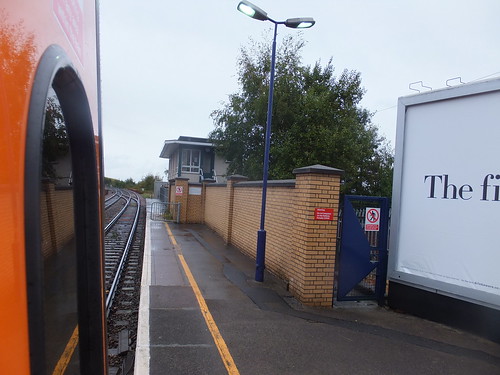 Warrington Central signal box.
Warrington Central signal box.
Warrington Central station buildings, with their glazed canopies, are quite impressive - I must try to return with time to appreciate them better.
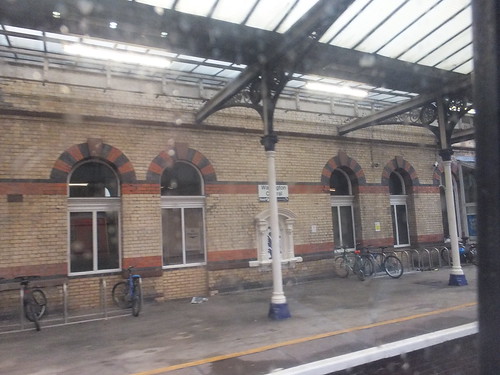 Station buildings on Up platform at Warrington Central.
Station buildings on Up platform at Warrington Central.
My train departed from Warrington across the 350 yard Warrington Viaduct, then crossed the West Coast Main Line (4-track, paired by direction between Warrington Bank Quay and Winwick Junction). We accelerated rapidly, flew through Sankey station and were soon braking for our stop at Widnes. Whereas the CLC provided a direct line for fast trains and a loop into the town at both Warrington and Widnes, at Warrington the direct line was abandoned but at Widnes, the loop into the town was abolished and the present Widnes station is actually Farnworth station renamed. I spotted a wooden 'Farnworth' nameboard dumped beside the station building but I couldn't determine if it was historic or a modern copy. The large brick station building on the Down side is quite attractive, but boarded-up and separated from the platform by a fence.
 Farnworth station building, now serving as 'Widnes'.
Farnworth station building, now serving as 'Widnes'.
The next five miles took us through stations at Hough Green, Halewood and Hunts Cross. The line straight ahead was the CLC to Liverpool Central but, from Hunts Cross, only Merseyrail trains operate the line so my train turned right onto the Down Hunts Cross Chord, joined the Crewe - Liverpool line at Allerton Junction signal box (another British Railways Standard Pattern signal box, this time with an 'oversize' brick-built ground floor) and came to a stand in platform 2 at the modern station of Liverpool South Parkway. This steel-and-glass transport interchange opened in 2006 and I first used it myself in 2010 when attending an OLCO Annual General Meeting (described here).
The train had only a five and a half mile dash to reach Liverpool Lime Street but I decided to 'bail out' and continue to Liverpool on the former CLC route, now operated by Merseyrail. My brief description of of the journey from Hunts Cross to Liverpool is in the post More Merseyrail.
 Allerton Junction Signal Box seen from Liverpool South Parkway Station. The Crewe lines are in front of the signal box - Up Fast, Down Fast, Up Slow, Down Slow. The diverging lines behind the signal box are Up Hunts Cross Chord and Down Hunts Cross Chord. The lines diverging further to the left serve Northern Rail's Allerton Traction Maintenance Depot (TMD).
Allerton Junction Signal Box seen from Liverpool South Parkway Station. The Crewe lines are in front of the signal box - Up Fast, Down Fast, Up Slow, Down Slow. The diverging lines behind the signal box are Up Hunts Cross Chord and Down Hunts Cross Chord. The lines diverging further to the left serve Northern Rail's Allerton Traction Maintenance Depot (TMD).
My pictures
North Wales Line (Crewe - Llandudno) (Pictures of Chester station).
CLC Chester - Manchester.
Manchester Metrolink.
Manchester Area Rail.
CLC Manchester - Liverpool.
Liverpool area rail.
